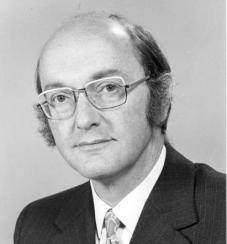
Vinton Gray Cerf is an American Internet pioneer and is recognized as one of "the fathers of the Internet", sharing this title with TCP/IP co-developer Bob Kahn. He has received honorary degrees and awards that include the National Medal of Technology, the Turing Award, the Presidential Medal of Freedom, the Marconi Prize, and membership in the National Academy of Engineering.

Paul V. Mockapetris is an American computer scientist and Internet pioneer, who invented the Internet Domain Name System (DNS).

Robert Elliot Kahn is an American electrical engineer who, along with Vint Cerf, first proposed the Transmission Control Protocol (TCP) and the Internet Protocol (IP), the fundamental communication protocols at the heart of the Internet.

Leonard Kleinrock is an American computer scientist and Internet pioneer. He is a long-tenured professor at UCLA's Henry Samueli School of Engineering and Applied Science.

Donald Watts Davies, was a Welsh computer scientist who was employed at the UK National Physical Laboratory (NPL).

Lynn Ann Conway is an American computer scientist, electrical engineer and transgender activist.

Paul Baran was a Polish-American engineer who was a pioneer in the development of computer networks. He was one of the two independent inventors of packet switching, which is today the dominant basis for data communications in computer networks worldwide, and went on to start several companies and develop other technologies that are an essential part of modern digital communication.

Robert Cailliau is a Belgian informatics engineer, computer scientist and author who proposed the first (pre-www) hypertext system for CERN in 1987 and collaborated with Tim Berners-Lee on the World Wide Web from before it got its name. He designed the historical logo of the WWW, organized the first International World Wide Web Conference at CERN in 1994 and helped transfer Web development from CERN to the global Web consortium in 1995. Together with James Gillies, Cailliau wrote How the Web Was Born, the first book-length account of the origins of the World Wide Web.

Barbara Liskov is an American computer scientist who has made pioneering contributions to programming languages and distributed computing. Her notable work includes the development of the Liskov substitution principle which describes the fundamental nature of data abstraction, and is used in type theory and in object-oriented programming. Her work was recognized with the 2008 Turing Award, the highest distinction in computer science.
Eric J. Bina is an American software programmer who is the co-creator of Mosaic and the co-founder of Netscape. In 1993, Bina along with Marc Andreessen authored the first version of Mosaic while working as a programmer at National Center for Supercomputing Applications (NCSA) at the University of Illinois at Urbana-Champaign.

Lawrence Gilman Roberts was an American engineer who received the Draper Prize in 2001 "for the development of the Internet", and the Principe de Asturias Award in 2002.

Radia Joy Perlman is an American computer programmer and network engineer. She is a major figure in assembling the networks and technology to enable what we now know as the internet. She is most famous for her invention of the spanning-tree protocol (STP), which is fundamental to the operation of network bridges, while working for Digital Equipment Corporation, thus earning her nickname "Mother of the Internet". Her innovations have made a huge impact on how networks self-organize and move data. She also made large contributions to many other areas of network design and standardization: for example, enabling today's link-state routing protocols, to be more robust, scalable, and easy to manage.

Glenn Ricart is a computer scientist. He was influential in the development of the Internet (ARPANET) going back to 1969 and early implementation of the TCP/IP protocol. Since then he has been active in technology and business as well as donating his time to philanthropic and educational movements.

John C. Klensin is a political scientist and computer science professional who is active in Internet-related issues.
BITNET was a co-operative U.S. university computer network founded in 1981 by Ira Fuchs at the City University of New York (CUNY) and Greydon Freeman at Yale University. The first network link was between CUNY and Yale.

Ira H. Fuchs is an internationally known authority on technology innovation in higher education and is a co-founder of BITNET, an important precursor of the Internet. He was inducted into the Internet Hall of Fame in 2017. Since 2012 he has been President of BITNET, LLC a consulting firm specializing in online learning and other applications of technology in higher education.

Lawrence Hugh Landweber is John P. Morgridge Professor Emeritus of computer science at the University of Wisconsin–Madison.

ACM SIGOPS is the Association for Computing Machinery's Special Interest Group on Operating Systems, an international community of students, faculty, researchers, and practitioners associated with research and development related to operating systems. The organization sponsors international conferences related to computer systems, operating systems, computer architectures, distributed computing, and virtual environments. In addition, the organization offers multiple awards recognizing outstanding participants in the field, including the Dennis M. Ritchie Doctoral Dissertation Award, in honor of Dennis Ritchie, co-creator of the C programming language and Unix operating system.
















